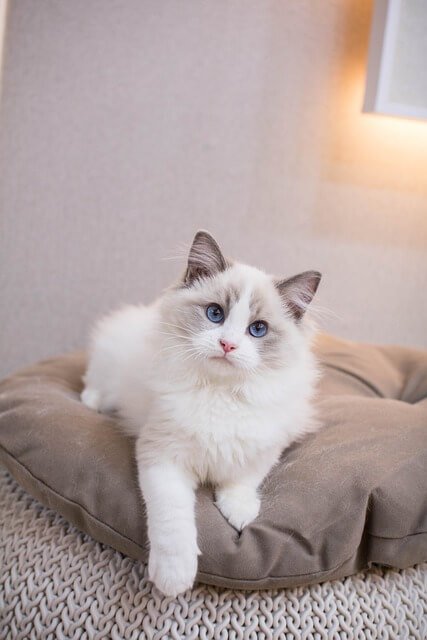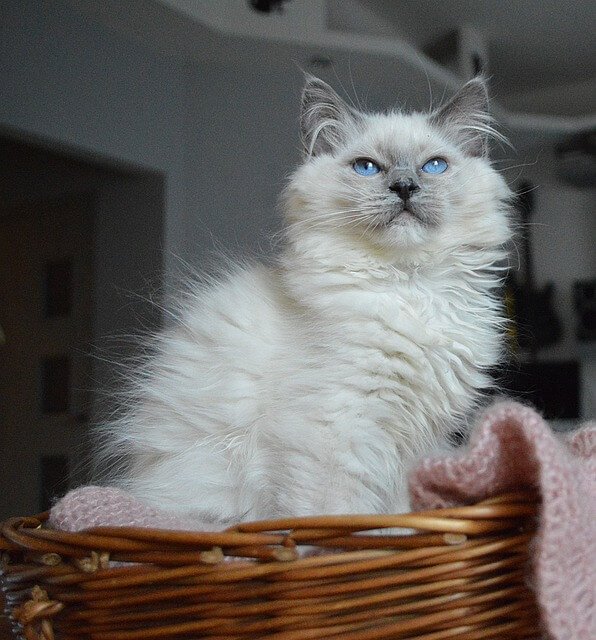The Ragdoll cat is known for its striking appearance, luxurious coat, and mesmerizing blue eyes. This breed’s distinctive physical traits make it one of the most beautiful and sought-after cats in the world.
From their soft, semi-long fur to their large, muscular build, Ragdolls are an absolute delight to look at.

In this guide, we’ll explore the coat colors, patterns, size, eye color, and overall body structure of Ragdoll cats to give you a complete understanding of their unique appearance.
Ragdoll Cat Appearance Size and Build
Table of Contents
Ragdolls are one of the largest domesticated cat breeds, with a strong yet elegant body structure. Below is a comparison of the Ragdoll’s size and weight compared to other popular cat breeds.
| Breed | Weight (Males) | Weight (Females) | Body Type |
| Ragdoll | 15–20 lbs | 10–15 lbs | Large & Muscular |
| Maine Coon | 15–25 lbs | 10–15 lbs | Large & Sturdy |
| Persian | 9–14 lbs | 7–11 lbs | Medium & Cobby |
| Siamese | 8–12 lbs | 6–10 lbs | Slender & Elegant |
Key Features of a Ragdoll’s Build:
- Large & Muscular: Unlike smaller breeds, Ragdolls have strong bone structures and a long body.
- Fluffy Semi-Long Coat: Their plush, silky fur gives them a regal look.
- Long Tail: A Ragdoll’s tail is bushy and well-furred, adding to its majestic appearance.
- Soft, Rounded Features: They have a broad head, rounded cheeks, and well-set ears, giving them a gentle expression.
Ragdoll Cat Coat Colors and Patterns
One of the most fascinating aspects of the Ragdoll’s appearance is its diverse range of coat colors and patterns. Their fur is soft, semi-long, and comes in various shades.
Ragdoll Coat Colors:
Ragdolls are available in six main colors:
| Color | Description |
| Seal | Dark brown points with a cream or fawn body. |
| Blue | Grayish-blue points with a lighter body. |
| Chocolate | Warm brown points with an ivory or cream-colored body. |
| Lilac | Soft grayish-pink points with a pale white body. |
| Red | Orange or flame-colored points with a white-cream body. |
| Cream | Pale cream-colored points with a nearly white body. |
Ragdoll Coat Patterns:
Ragdolls exhibit a variety of stunning patterns, including:
| Pattern | Description |
| Colorpoint | Darker shades on the ears, face, paws, and tail, with a lighter body. |
| Mitted | Similar to Colorpoint, but with white paws, chin, and belly stripe. |
| Bicolor | White chest, belly, legs, and sometimes a white inverted “V” on the face. |
| Lynx | A striped pattern overlaying any of the above. |
| Tortie | A blend of two colors, often red or cream mixed with another shade. |
Eye Color and Facial Features
One of the most enchanting aspects of the Ragdoll cat is its eye color.
Ragdoll Eye Color Chart
| Eye Color | Description |
| Deep Blue | The most common and signature Ragdoll eye color. |
| Sapphire Blue | A brighter, more vibrant blue shade. |
| Light Blue | Seen in some variations of Ragdoll coat patterns. |
Additional Facial Features:
- Sweet, expressive face with a gentle and loving gaze.
- Medium-sized ears with rounded tips that tilt slightly forward.
- Soft pink nose and full cheeks, adding to their adorable appearance.
Ragdoll Cat Coat Maintenance
Since Ragdolls have semi-long fur, they require regular grooming to keep their coat healthy and tangle-free.

Grooming Needs:
| Grooming Task | Frequency |
| Brushing | 2–3 times per week |
| Bathing | Every 6–8 weeks |
| Nail Trimming | Every 2–3 weeks |
| Ear Cleaning | Monthly |
| Eye Cleaning | As needed |
Tips for Coat Care:
✔ Use a wide-tooth comb to prevent matting.
✔ Focus on the belly and behind the ears, as these areas are prone to tangling.
✔ Regular brushing reduces shedding and keeps their coat soft.
Comparison: Ragdoll vs. Other Fluffy Cat Breeds
| Feature | Ragdoll | Maine Coon | Persian | British Longhair |
| Coat Type | Semi-long | Long | Long | Thick & Plush |
| Shedding | Moderate | High | High | Moderate |
| Size | Large | Largest | Medium | Medium |
| Eye Color | Blue | Green, Gold, Copper | Blue, Green, Copper | Gold, Blue, Green |
| Grooming Needs | Medium | High | Very High | Medium |
Ragdoll Cat Body Proportions
Ragdolls have a well-balanced body with proportional limbs, head, and tail that contribute to their graceful look.
Key Body Proportion Features:
- Legs: Medium-length with sturdy, well-muscled hind legs slightly longer than the front legs.
- Paws: Large, round, and tufted, adding to their plush look.
- Neck: Short and strong, blending smoothly into the broad chest.
Fur Texture and Seasonal Coat Changes
Ragdolls shed minimally compared to other long-haired breeds, but their coat changes slightly with the seasons.
Coat Variations by Season:
| Season | Coat Changes |
| Summer | Lighter, less dense coat to keep cool. |
| Winter | Thicker, fluffier fur for warmth. |
✔ Note: Even though they don’t have an undercoat, regular grooming is necessary to prevent tangles.
Tail Characteristics of Ragdoll Cats
The Ragdoll’s tail plays a key role in its majestic appearance.
Tail Features:
- Long, fluffy, and well-plumed, adding elegance.
- Moves gracefully, often curling slightly when relaxed.
- Used for communication, indicating mood through subtle movements.
Whiskers and Nose Structure
Whisker Details:
- Long, prominent, and slightly curved.
- Act as sensory tools, helping with navigation.
Nose Shape:
- Medium-length nose with a gentle curve (not flat like a Persian or pointed like a Siamese).
- Often soft pink, matching their light facial features.
Sepia Ragdoll Cat: Appearance, Care, and Prices
Ragdoll Cat Appearance Female

Female Ragdoll cats are slightly smaller and more petite than their male counterparts but still maintain the breed’s graceful and elegant appearance.
They have large, expressive blue eyes, a soft semi-long coat, and a well-proportioned body. Their fur comes in various patterns such as colorpoint, mitted, and bicolor, with shades including seal, blue, chocolate, lilac, and cream.
Compared to males, female Ragdolls often have a slightly more refined face shape, giving them a delicate and feminine look.
Their coats remain silky and plush without an undercoat, making grooming easier. Despite their smaller size, female Ragdolls are still larger than the average domestic cat, showcasing the breed’s signature strong yet elegant physique.
Ragdoll Cat Behavior Problems
Despite their loving and affectionate nature, Ragdolls can exhibit certain behavior problems if their needs are not met.
Excessive meowing, separation anxiety, and destructive behavior are common issues, often arising from boredom or lack of attention. Some Ragdolls may also develop litter box problems due to stress or dirty litter.
Aggression in Ragdolls is rare, but they may show territorial tendencies or rough play behavior, especially if not properly socialized.
Unneutered males might spray urine, while females in heat can become excessively vocal. To prevent these issues, it’s crucial to provide a structured environment, interactive toys, and proper training.
Bad Things About Ragdolls
While Ragdolls are adored for their affectionate nature, they do have some downsides that potential owners should consider.
Their constant need for attention can be overwhelming for those who prefer low-maintenance pets. If left alone for long periods, Ragdolls may develop separation anxiety, excessive vocalization, or destructive habits.
Additionally, Ragdolls shed moderately, requiring regular grooming to prevent matting. Their lack of street smarts makes them unsuitable for outdoor life, as they may wander into danger without realizing it.
Despite these challenges, with proper care and attention, Ragdolls remains one of the most affectionate and loyal cat breeds.
Ragdoll Cat Size
Ragdolls are among the largest domesticated cat breeds, with males typically weighing 15 to 20 pounds and females weighing 10 to 15 pounds.
Their long, muscular bodies and broad chests give them a solid yet elegant appearance. Unlike some breeds that mature quickly, Ragdolls take 3 to 4 years to reach their full size and coat development.
Their long, fluffy tails and soft fur add to their overall majestic look. Despite their large size, Ragdolls remain gentle and easygoing, making them ideal lap cats.
Their slow growth rate and sturdy build set them apart from smaller, more delicate breeds, adding to their unique charm.
Ragdoll Cat Behavior
Ragdolls are known for their docile, affectionate, and social behavior, making them one of the most people-oriented cat breeds.
They love cuddling, being carried, and following their owners from room to room. Unlike more independent cats, Ragdolls seek constant companionship and may even greet their owners at the door. Their gentle and floppy nature when picked up is one of their most endearing traits.
While they are generally calm and friendly, Ragdolls can also be playful and curious. They enjoy interactive play, puzzle toys, and gentle games that stimulate their minds.
However, they are not very streetwise and should be kept indoors for their safety. Their affectionate personality makes them prone to separation anxiety, so they do best in homes where they receive plenty of attention.
Conclusion
The Ragdoll cat’s appearance is a perfect mix of elegance, softness, and charm. With their luxurious fur, captivating blue eyes, and large yet graceful build, they are truly one of the most beautiful breeds. Their varied coat colors and patterns add even more uniqueness to their look.
If you’re considering adopting a Ragdoll, knowing their size, coat maintenance, and unique physical traits will help you appreciate their beauty even more. Whether you love their silky fur, affectionate gaze, or fluffy tail, Ragdolls are a visual delight that cat lovers adore.
Would you like help choosing the best grooming tools for your Ragdoll? Let us know in the comments! 🐾😊
FAQ about Ragdoll Cat Appearance
What do Ragdoll cats look like?
Ragdoll cats have a large, muscular body with a soft, semi-long coat and striking blue eyes. Their fur is silky and plush, and they come in various color patterns, including colorpoint, mitted, and bicolor.
What are the physical characteristics of a Ragdoll cat?
Ragdolls are large, well-proportioned cats with a broad chest, sturdy legs, and a long, fluffy tail. They have rounded ears, a slightly curved nose, and expressive whiskers. Their coat lacks an undercoat, making it easier to maintain compared to other long-haired breeds.
How to tell if a cat is a Ragdoll?
You can identify a Ragdoll by its docile personality, striking blue eyes, and semi-long silky coat. Unlike most breeds, Ragdolls tend to go limp when picked up, which is a unique trait of this breed. Their size, soft fur, and distinctive pointed color patterns (dark ears, face, paws, and tail) are also key identifiers.
What is unique about Ragdolls?
Ragdolls are famous for their affectionate nature, docile temperament, and tendency to follow their owners like a dog. They are less independent than other breeds, thrive on companionship, and often greet their owners at the door. Their gentle and floppy nature makes them excellent lap cats.
Are Ragdolls expensive?
Yes, Ragdoll cats can be expensive, with prices ranging from $800 to $2,500, depending on their lineage, color pattern, and breeder reputation. Show-quality Ragdolls or those with rare coat variations can cost even more.
Which Ragdoll is rare?
The lilac and chocolate Ragdolls are considered the rarest due to their recessive genetic traits. Mink, sepia, and solid Ragdolls, which have darker and richer fur tones, are also less common than traditional Ragdoll colors.

